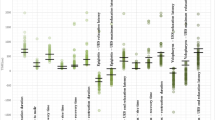Abstract
The lower-esophageal high-pressure zones (LEHPZ) of 10 normal subjects, 8 patients with hiatus hernia and one patient with progressive systemic sclerosis (PSS) were investigated using a special 8-lumen recording catheter, the lateral orifices of which were spaced at 45° intervals around the circumference of the catheter. While similar pressures were recorded from all orifices within the stomach and esophageal body, pressures within the LEHPZ were found to be related to spatial orifice position. In normal subjects, but not in patients with hiatus hernia, a significantly higher localized pressure was detected by orifices directed toward the left posterior quadrant of the circumference of the distal esophagus, while a lesser, rather uniform, pressure was recorded from the other three quadrants. From the PSS patient, who had severe gastroesophageal reflux, a LEHPZ was detected only in the left posterior quadrant. The results suggest that the recorded LEHPZ represents the summation of two factors: an intrinsic force possibly due to a physiologic loweresophageal sphincter and an extrinsic force possibly resulting from compression of the distal esophagus by the lateral margin of the diaphragmatic hiatus.
Similar content being viewed by others
References
Fyke FE Jr, Code CF, Schlegel JF: The gastroesophageal sphincter in healthy human beings. Gastroenterologia 86:135–150, 1956
Cohen S, Harris LD: Lower esophageal sphincter prssure as an index of lower esophageal sphincter strength. Gastroenterology 58:157–162, 1970
Pope CE II: Is LES enough? Gastroenterology 71:328–331, 1976 (editorial)
Kaye MD, Showalter JP: Manometric configuration of the lower esophageal sphincter in normal human subjects. Gastroenterology 61:213–223, 1971
Winans CS: The pharyngoesophageal closure mechanism: A manometric study. Gastroenterology 63: 768–777, 1972
Castell DO, Levine SM: Lower esophageal sphincter response to gastric alkalinization. Ann Intern Med 74:223–227, 1971
Winans CS, Harris LD: Quanitation of lower esophageal sphincter competence. Gastroenterology 52:773–778, 1967
Pope CE II: A dynamic tests of sphincter strength: Its application to the lower esophageal sphincter. Gastroenterology 52:779–786, 1967
Cohen S, Harris LD: Does hiatus hernia affect competence of the gastroesophageal sphincter? N Eng J Med 284:1053–1056, 1971
Haddad JK: Relation of gastroesophageal reflux to yield sphincter pressures. Gastroenterology 58:175–184, 1970
Dilawari JB, Edwards DAW, Girmes DH: The probability of symptoms or of radiographic evidence of reflux predicted by lower esophageal sphincter pressure. Proceedings of the Fourth International Symposium on Gastrointestinal Motility. Mitchell Press, Vancouver, 1973, pp 441–448
Behar J, Biancani P, Sheahan DG: Evaluation of esophageal tests in the diagnosis of reflux esophagitis. Gastroenterology 71:9–15, 1976
Author information
Authors and Affiliations
Additional information
Partial support of this work was provided by the Gastro-Intestinal Research Foundation, Chicago, Illinois.
Rights and permissions
About this article
Cite this article
Winans, C.S. Manometric asymmetry of the lower-esophageal high-pressure zone. Digest Dis Sci 22, 348–354 (1977). https://doi.org/10.1007/BF01072193
Issue Date:
DOI: https://doi.org/10.1007/BF01072193




